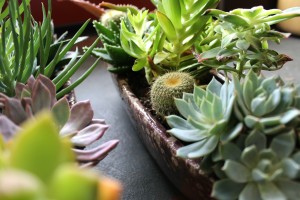by Monica Yearwood
Part II of a two-part series on cultivating nature in your home as a city dweller.
As yoga’s “sister science,” Ayurveda teaches us that by living in alignment with the cycles in nature, we enhance health in body and contentment in mind. When we become disjointed from these cycles, we foster disease processes and emotional discordance. Living in a city environment poses unique challenges and opportunities for closing the gap between self and nature. Incorporating the elements of nature—specifically through lighting and essential oils—can close the gap that distances us by replicating the sun and earth cycle in our home.
The Trouble With Artificial Lighting
As humans, we are constantly under the influence of the environments created by our modern conveniences. Artificial lighting is one such factor that has a very real impact on our circadian rhythm, and the glow emitted from TVs, computers, streetlights, neighboring buildings and indoor overhead lighting is difficult to escape in the city.
The impact of artificial lighting on our physiology is associated with the development of mood disorders, seasonal affective disorder (SAD) and heart disease, among other health issues. In 2012, the American Medical Association released a concerning summary of adverse health effects from artificial lighting, citing that a lack of complete exposure to darkness interrupts melatonin secretion and significantly decreases the body’s ability to fight tumor growth and cancers.
Replicating the light dark cycle in our home
Ayurveda emphasizes daily lifestyle practices that synchronize our activities with the sun’s cycle. Collectively, these practices are referred to as dinacharya, which means, “to follow the day.” This means following the day as led by the sun—rising with the sun, eating at midday when the sun is strongest, and sleeping after the sun has set.
The ability to embrace these practices effortlessly, specifically through aligning the sleep cycle with the natural light/dark cycle of the sun, expresses circadian rhythm health. However, exposure to chronic light stimulation negatively impacts our physiology and diminishes melatonin secretion, which may inhibit a natural desire for sleep. Fortunately, by being deliberate about daily exposure to light and darkness, we can reduce the impact of artificial lighting through two methods.
Exposure to bright light during the day for at least one half-hour.
If it truly is impossible to get outside for that time, purchase a bright light machine and keep it at your desk. Dr. David Edelberg, founder of Whole Health Chicago, advises consistent bright light exposure in the morning. In the winter, when temperatures are low, he suggests using light box machines that deliver full spectrum lighting (the same type of light that we receive from the sun) to powerfully suppress melatonin secretion. The suppression of melatonin acts like a rubber band, causing the body to secrete more melatonin at night, raise serotonin levels, and regulate circadian rhythms to promote better sleep.
Make sure that your room is completely dark when you sleep.
Light coming in from ineffective curtains can impede melatonin secretion, and the light from even a single lightbulb can suppress melatonin secretion. Purchase blackout curtains for your sleeping areas and explore blue light blocking devices, as the blue light in the spectrum suppresses melatonin secretion. Block this light with lenses that cover the computer and TV screen, and wear special glasses to block out blue light. Explore lowbluelights.com for a solution that will work for you.
Using Essential Oils In The Home
Essential oils are the natural aromatic compounds extracted from seeds, bark, stems, roots, flowers, and other parts of plants using distillation, chemical or expression methods. While essential oils naturally contain the scent of the plants from which they were extracted, they also possess compounds that affect human physiology in numerous ways unrelated to their actual scent. In fact, research cited in an October 2014 New York Times article explains that we have scent receptors throughout our entire body that respond to the chemicals in aroma.
David Crow, pioneer of the Grassroots Healthcare movement and founder of Floracopeia Essential Oils, explains that essential oils have a range of functions depending on the oil, including relaxant and anti-anxiety, antidepressant and antimicrobial. “Whenever we use a plant
for medicine, it helps our body remember its connection to nature. The more mindfully we do this, the more we can connect our consciousness to nature as well,” Crow says. “Just breathing the fragrance of a plant connects the body biologically to that plant.”
Ayurvedic medicine uses essential oils, topically and through inhalation, to reduce doshic excess, restore hormonal function and help mitigate a variety of disorders.
For those new to essential oils, Crow suggests starting simple with single oils in a diffuser, such as lavender, and to avoid using them directly on the skin or taking essential oils internally. “Using oils in simple personal routines that mark the cycles of the day and seasons is very helpful also, just as eating and sleeping at regular times helps maintain the biorhythms.”
Below, Crow details what specific essential oils can bring to the home:
- Conifer Oils: The life force of the forest; boosts immunity
- Flower Oils: The springtime and sunshine; helps harmonize the female hormonal cycle
- Root Oils: The earth element; helps calm the mind
- Sacred Scents, such as frankincense and palo santo: Connects you with ancient rituals; uplifts your consciousness.
Monica Yearwood is an ayurvedic practitioner, author, speaker and founder of Hamsa Ayurveda & Yoga.

























No Responses to “Ayurveda: Bringing the Outdoors In”